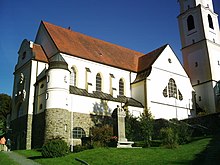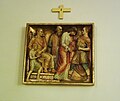St. Johannes Nepomuk (Bayerisch Eisenstein)
The Catholic parish church of St. Johannes Nepomuk is a listed church building in Bayerisch Eisenstein , a municipality in the Lower Bavarian district of Regen .
Predecessor churches
A mansion with a castle chapel was built after 1771 at the Bayerisch Häusl by the lord of the court, Franz Ignaz von Hafenbrädl. The brick apse of this chapel is still preserved. However, the main church life continued to take place in Böhmisch Eisenstein. The chapel was enlarged, but soon too small again. From 1842 to 1844 a new church was built at Bayerisch Häusl, which at the end of the 19th century became too small due to the increasing population of the place and was also poorly located.
Today's church
It took some time before the community could agree on a suitable building site. In order to secure the financing, a church lottery and a state collection were organized, the project was supported by the Hohenzollern House , which had owned the Hofmark since 1872.
The building was constructed from 1908 to 1909 in the neo- baroque style. The master builder was the Munich architect Hans Schurr . The church is under the patronage of St. John Nepomuk and was consecrated on October 19, 1919 by the Bishop of Regensburg . On the north wall is the inscription Memorial Church for His Royal Highness the Most Serene Prince Leopold von Hohenzollern, the greatest benefactor of the poor . The building is 43 meters long, 19.5 meters wide and 23 meters high, the tower is 45 meters high and was completed in the winter of 1908.
Color window
The colored window depicting Johannes Nepomuk floating up to the sky after falling into the Vltava was painted in 1961 by E. Schwankl from Eisenstein based on a design by the architect Rothemund from Zwiesel . Thekla Putz donated the window. On the opposite side is a window depicting the Sorrowful Mother. It was made in 1926 in the Zettler glass painting workshop in Munich. The window was donated in memory of Robert Segl from Straubing, who was killed in a car accident.
Furnishing
- The high altar is a work by Bruno Diamant from Munich, it is flanked in the upper area by the figures of Saints Wilhelm and Leopold. The two figures in the lower area represent the Bishop Augustine and Pope Gregory the Great . Both figures were made around 1750 in the Rococo style, the artist is unknown.
- The left side altar previously served as the main altar of the Expositurkirche . The simple baroque work was created around 1680.
- The figure of Mary on the left side altar was made by an unknown master from Bohemia. It was donated by Therese Puchinger.
- The crucifixion group on the left side altar was created around 1911 by the sculptor Grau from Regensburg.
- The pulpit and the altar in the right transept are also works by Bruno Diamant.
- The altar sheet above the high altar was installed in 1968. It was painted by Johann Rotter in 1690 and shows the fourteen helpers in need . The new ornamental frame was carved by Jakob Helmer from Regensburg in 1968. The picture originally hung in the former Expositurkirche.
- A Way of the Cross hangs on the walls, the artist is not known.
- Carved figures by various artists hang on the pillars and walls:
| designation | Creation time | Name of the artist |
|---|---|---|
| St. Margaret | around 1750 | not known |
| St. John Nepomuk | around 1800 | not known |
| St. Florian | around 1800 | not known |
| St. Barbara | around 1750 | not known |
| St. Notburga | not known | not known |
| St. Alois | around 1800 | not known |
| Saint Anthony of Padua | 1962 | Franz Heuschneider from Aidenbach |
- The baptismal font is decorated with a depiction of the baptism of Jesus, the work was created around 1750.
- In the middle of the church hangs an elaborate crystal chandelier, it was delivered in 1972 by the Rimpler company from Zwiesel and donated by the Scheidl siblings.
- The front altar and the ambo were made in 1996 by the stone sculptors Herbert and Otto Preuss
Others
- The big bell was drafted for war purposes in 1917. It was found again in 1947 at the Hamburg bell cemetery and brought back.
- In memory of the fall of the Iron Curtain , a human chain with around 50,000 participants formed here on February 3, 1990, leading to the church in Železná Ruda .
Views
literature
- Churches, monasteries, pilgrimage routes in Germany. Sacred cultural property in Lower Bavaria and Upper Palatinate . United Churches-Kulturbuchverlage AG Haßloch, 1998, ISBN 3-901819-07-X
Web links
Individual evidence
- ↑ Previous building
- ↑ Planning and financing
- ↑ a b Churches, monasteries, pilgrimage routes in Germany. Sacred cultural property in Lower Bavaria and Upper Palatinate . United Churches-Kulturbuchverlage AG Haßloch, 1998, ISBN 3-901819-07-X , p. 28
- ↑ Tower building ( Memento of the original from March 6, 2016 in the Internet Archive ) Info: The archive link was inserted automatically and has not yet been checked. Please check the original and archive link according to the instructions and then remove this notice.
- ↑ a b Churches, monasteries, pilgrimage routes in Germany. Sacred cultural property in Lower Bavaria and Upper Palatinate . Vereinigte Kirchen- Kulturbuchverlage AG Haßloch, 1998, ISBN 3-901819-07-X , p. 27
- ↑ human chain
Coordinates: 49 ° 7 ′ 7.5 ″ N , 13 ° 11 ′ 58.2 ″ E






